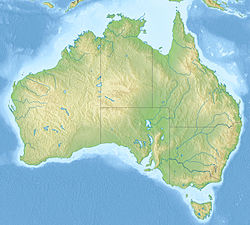Tasmanian Wilderness
| UNESCO World Heritage Site | |
|---|---|
 Cradle Mountain and Dove Lake, Central Highlands | |
| Location | Tasmania, Australia |
| Criteria | Cultural: iii, iv, vi, vii; natural: viii, ix, x |
| Reference | 181 |
| Inscription | 1982 (6th Session) |
| Extensions | 1989 |
| Area | 1,584,233 ha |
| Coordinates | 41°35′S 145°25′E / 41.583°S 145.417°E |


The Tasmanian Wilderness is a term that is used for a range of areas in Tasmania, Australia.
The World Heritage Areas in South West Tasmania, Western Tasmania and Central Highlands are the most well known.
However, there are also other wilderness areas in Tasmania, Tarkine and the Cradle mountain wilderness. There is also an organisation known as the Tasmanian Wilderness Society.
The World Heritage Area is one of the largest conservation areas in Australia, covering 13,800km², or almost 20% of Tasmania. The area constitutes one of the last expanses of temperate wilderness in the world, including the renowned South West Wilderness. The area became a UNESCO World Heritage Site in 1982, and it was extended in 1989. It is important for both its natural value but also its cultural values as well.
Remains found in limestone caves show that humans have lived in the area for well over 20,000 years.[3]
The Tasmanian Tiger was the largest Dasyuromorphia[2] and the last living specimen of the family Thylacinidae. The last known specimen died in captivity in 1936.[1]p77 The world's largest surviving carnivorous marsupial is the Tasmanian Devil; it is the size of a small dog and can hunt, although it is mainly a scavenger.[2]p46 It became extinct on the mainland some 600 years ago, and is now found only in Tasmania.[1]p69
World Heritage area
[change | change source]The following National Parks and reserves make up the Tasmanian Wilderness World Heritage Area:
- Cradle Mountain-Lake St Clair National Park[4]
- Franklin-Gordon Wild Rivers National Park
- Hartz Mountains National Park
- Mole Creek Karst National Park
- Southwest National Park
- Walls of Jerusalem National Park
- Central Plateau Conservation Area
- Devils Gullet State Reserve
- South East Mutton Bird Islet


Related pages
[change | change source]References
[change | change source]- ↑ 1.0 1.1 1.2 Egerton L. (ed) 2005. Encyclopedia of Australian wildlife. Reader's Digest. ISBN 1-876689-34-X
- ↑ 2.0 2.1 2.2 Menkhorst P.W. & Knight F. 2004. A field guide to the mammals of Australia. Oxford University Press ISBN 0-19-555037-4
- ↑ whc.unesco.org https://whc.unesco.org/en/list/181/. Retrieved 2024-11-14.
{{cite web}}: Missing or empty|title=(help) - ↑ "Cradle Mountain - Introduction". Parks and Wildlife Service Tasmania. 2012. Archived from the original on 10 May 2012. Retrieved 22 April 2012.
Other websites
[change | change source]![]() Media related to Tasmanian Wilderness World Heritage Area at Wikimedia Commons
Media related to Tasmanian Wilderness World Heritage Area at Wikimedia Commons
- World heritage listing for Tasmanian Wilderness
- Tasmanian Parks & Wildlife Service site Archived 2008-10-07 at the Wayback Machine
- Position of World Heritage Area Archived 2007-09-07 at the Wayback Machine
- UNESCO site
41°34′59″S 145°25′01″E / 41.583°S 145.417°E

